Majoritatea aplicațiilor populare au un mod sigur care permite utilizatorilor să ruleze programul cu funcționalități limitate atunci când lucrurile nu rulează așa cum ar trebui. Așa este cazul cu Outlook - un manager de e-mail complex care utilizează modul sigur pentru a ocoli o mulțime de probleme care îl împiedică să pornească. S-ar putea să lansați Outlook în mod sigur, în mod intenționat, dar poate începe și în acest mod de unul singur.

Dacă nu ați inițiat singur Modul sigur din orice motive, nu vă voi sfătui să continuați să utilizați Outlook în acest mod. Nu veți putea salva șabloane, preferințe și nu veți putea folosi etichete inteligente, printre altele. Dacă vă aflați în acest tip de situație, vă recomandăm să tratați modul sigur ca instrument de diagnosticare și să vă rezolvați problema.
Când este folosit modul sigur în OutLook
Outlook va actualiza în mod regulat registrul de sistem pentru a permite noilor extensii pe care le instalați să funcționeze așa cum ar trebui. Dacă programul detectează la lansare o problemă care îl împiedică să ruleze, va trece automat la modul sigur . Acest lucru se întâmplă de obicei imediat după instalarea unui nou program de completare care nu se joacă bine cu versiunea dvs. Outlook.
Puteți declanșa singur modul sigur deschizând o fereastră Run și tastând Outlook / safe și apăsând OK .

În cazul în care Outlook pornește automat în modul sigur , este de obicei un semn că ceva nu funcționează corect. Uneori, Outlook va reuși să identifice componenta de completare care împiedică pornirea normală a Outlook-ului. Dacă vă cere să dezactivați componenta defectă, încercați și vedeți dacă Outlook reușește să pornească normal.

Declanșatorii potențiali ai modului sigur
Dacă utilizați versiunea 2010, problema dvs. este cel mai probabil cauzată de actualizarea KB3114409 care face ca Outlook să pornească în modul sigur și să revină la setările implicite. În cazul în care utilizați o versiune mai veche de Outlook, cum ar fi 2007 sau 2003, problema dvs. ar putea fi legată de serviciul de căutare Windows . Completarea greșită poate intra, de asemenea, în conflict cu versiunea dvs. Outlook până la punctul în care o veți forța să înceapă în modul sigur .
Aceștia sunt doar trei dintre potențialii vinovați, dar cauzele pot proveni din multe locuri.
Mai jos aveți o colecție de remedieri care au ajutat deja mulți utilizatori să împiedice Outlook să ruleze în modul sigur . Urmați metodele de mai sus, în ordine, în conformitate cu versiunea dvs. Outlook până când găsiți o soluție care vă rezolvă problema.
Metoda 1: Dezactivarea programelor de completare în modul sigur (toate versiunile Outlook)
Acesta este un eveniment obișnuit în fiecare versiune Outlook de la Outlook 2007 la Outlook 2016 . Acest lucru se întâmplă deoarece anumite programe de completare vor intra în conflict cu versiunea dvs. Outlook. Acest lucru este chiar mai probabil cu programe de completare învechite instalate pe cele mai recente versiuni de Outlook.
Notă: Dacă ați instalat programul de completare ABBYY FineReader înainte ca această eroare să înceapă, urmați pașii de mai jos pentru a elimina programul de completare din versiunea dvs. Outlook.
- Confirmați că Outlook este în modul sigur, verificând dacă pictograma din bara de activități are un semn de exclamare.

Notă: Puteți confirma, de asemenea, căutând dacă vedeți (Mod sigur) în secțiunea de sus a ecranului.

- Acum, extindeți fila Fișier și faceți clic pe Opțiuni .
- Acum faceți clic pe fila Complimente . De acolo, accesați meniul derulant de lângă Gestionați și selectați Complete COM din listă. Faceți clic pe Go pentru a continua.
- În acest moment, ar trebui să faceți o captură de ecran a listei de suplimente și să o salvați undeva convenabil. Acest lucru vă va ajuta să restabiliți configurația normală a Outlook-ului dvs. dacă apar defecțiuni după ce dezactivați programele de completare.
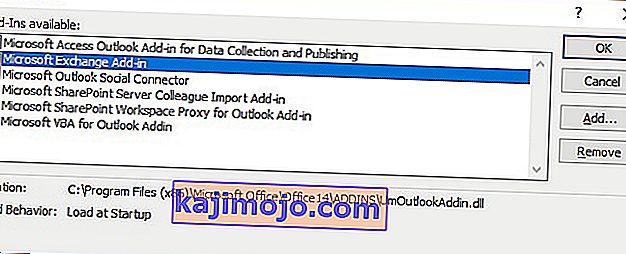
- Dezactivați fiecare intrare (debifați casetele de selectare selectate) și apăsați OK .
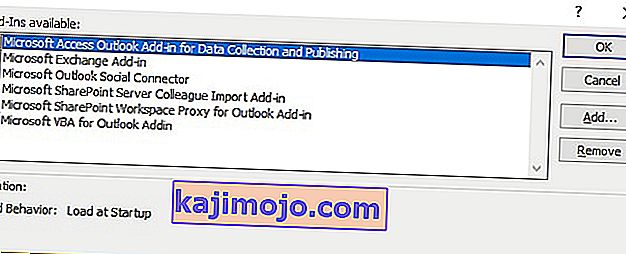 Notă: nu apăsați încă Eliminare . Mai întâi trebuie să confirmăm că acestea cauzează problema.
Notă: nu apăsați încă Eliminare . Mai întâi trebuie să confirmăm că acestea cauzează problema. - Închideți Outlook și deschideți-l din nou. Dacă programul pornește în modul normal, problema dvs. a fost rezolvată.
Notă: În cazul în care pornește în continuare în modul sigur , accesați Opțiuni fișier> Suplimente și reactivați suplimentele pe care le-am dezactivat la pasul 5 și treceți la Metoda 2 .
- Reveniți la Fișier> Opțiune> Suplimente și reactivați sistematic fiecare completare unul câte unul până când îl dezvăluiți pe cel care cauzează conflicte.
- Selectați-l și apăsați Eliminare .
- Reporniți Outlook și vedeți dacă pornește în modul normal.
Metoda 2: Restabiliți computerul utilizând Restaurarea sistemului (toate versiunile Outlook)
Restaurarea sistemului este o caracteristică Windows care permite utilizatorilor să-și revină starea computerului la un moment anterior. Acest lucru ne servește scopului dacă putem reveni la o stare anterioară în care Outlook a început să funcționeze defectuos. Iată ce trebuie să faceți:
- Țineți apăsată tasta Windows și apăsați R. Tastați rstrui.exe și faceți clic pe OK .
- În fereastra Restaurare sistem, selectați Alegeți un punct de restaurare diferit și apăsați Următorul.
- Îngroșați caseta de lângă Afișați mai multe puncte de restaurare.
- Găsiți un punct când Outlook funcționa, apoi alegeți acel punct de restaurare și continuați cu instrucțiunile de pe ecran pentru a restabili computerul la o dată anterioară.
- Odată ce acest lucru este făcut, sistemul va începe restaurarea. După terminarea restaurării, verificați dacă Outlook funcționează. dacă nu, treceți la Metoda 3 .
Metoda 3: Restabiliți la o versiune anterioară a Outlook
Dacă restabilirea sistemului de operare desktop la o versiune anterioară nu a funcționat, să încercăm să restaurez Outlook la o versiune anterioară. Iată cum:
- Faceți clic pe Start și tastați Outlook.exe în dialogul de căutare. Faceți clic dreapta pe el și alegeți Proprietăți .
- Apoi accesați fila Versiuni anterioare și găsiți fișierul Outlook.exe care are o dată când a funcționat. Faceți clic pe Deschidere pentru a vedea dacă funcționează și se deschide fără Mod sigur .
 Notă: Asigurați-vă că Outlook nefuncțional care a fost deschis anterior în modul sigur este închis deoarece rulăm acum una dintre copiile salvate în versiunile anterioare. Faceți același lucru pentru toate versiunile enumerate acolo. Deschide / Închide până când o vezi pe cea care se deschide fără Mod sigur. Dacă funcționează, păstrați fereastra deschisă.
Notă: Asigurați-vă că Outlook nefuncțional care a fost deschis anterior în modul sigur este închis deoarece rulăm acum una dintre copiile salvate în versiunile anterioare. Faceți același lucru pentru toate versiunile enumerate acolo. Deschide / Închide până când o vezi pe cea care se deschide fără Mod sigur. Dacă funcționează, păstrați fereastra deschisă. - Presupunând că aveți acum versiunea de Outlook care rulează, fără Mod sigur de la una dintre versiunile anterioare. Țineți tasta Windows și apăsați pe r . Tastați taskmgr și faceți clic pe OK .
- În fereastra Manager activități , accesați fila Proces , localizați Outlook.exe , faceți clic dreapta pe ea și alegeți Deschidere locație fișier.
- Copy all the files from the next window, then navigate to C:\Program Files (x86)\Microsoft Office\Office. Paste the filed previously copied here.
- Try to re-open Outlook and see if it starts in normal mode.
Method 4: Uninstalling the KB3114409 update ( Outlook 2010)
Sometime in 2015, Microsoft issued a security patch that caused Outlook to run in Safe Mode and revert it back to the default configuration. The user-made configurations aren’t lost forever and will be back when Outlook manages to boot up in normal mode.
If you have this problem, there are two ways to proceed forward. Since Microsoft issued an update that fixes the problem caused by KB3114409, we can install that over the bad update. A different route would be to simply uninstall the KB3114409.
We highly recommend you to go for installing the official Microsoft update fix. But regardless of which option you opt for, we will guide you through the whole process.
Using the official Microsoft fix
Microsoft update KB3114560 was issued specifically to fix the damage done by KB3114409. As a rule of thumb, you should always install security updates from the official website. Here’s what you need to do:
- Access this official link and click on one of the two different update versions, according to your PC specs.
- Select the default language of your Outlook program and click on the Download button.
- Once the update has been downloaded, open the executable and follow through with the installation process.
- Restart your PC, open Outlook again and see if the issue has been resolved.
Uninstalling the KB3114409 update
- Close Outlook completely.
- Open Control Panel, click on Uninstall a program.
- Once you’re in the Programs and Features window, click on View installed updates.

- Use the Search Installed Updates search bar in the top-right corner to search for the bad update (KB3114409 ).

- Once you manage to identify the bad update, click the Uninstall button and follow through with the confirmation prompts.
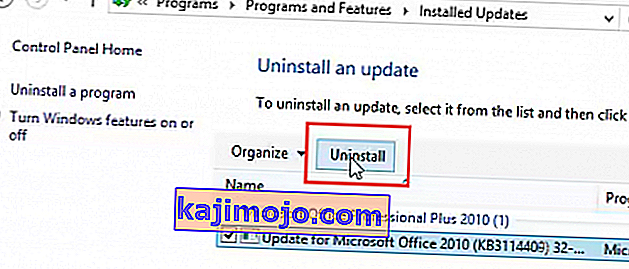
- Restart your PC, open Outlook and see if the issue repeats.
Method 5: Doing an Outlook Profile reset (All Outlook versions)
If you experience hanging at the initial Outlook splash screen (right before it initiates Safe Mode), you might need to do a profile reset. Here’s how to do it:
- Go to Control Panel > Mail and click on Show Profiles.
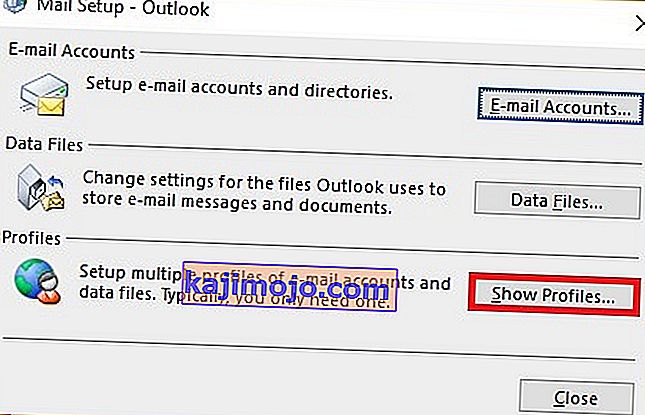
- Now, create a new profile by clicking the Add button. Insert a name and hit OK.
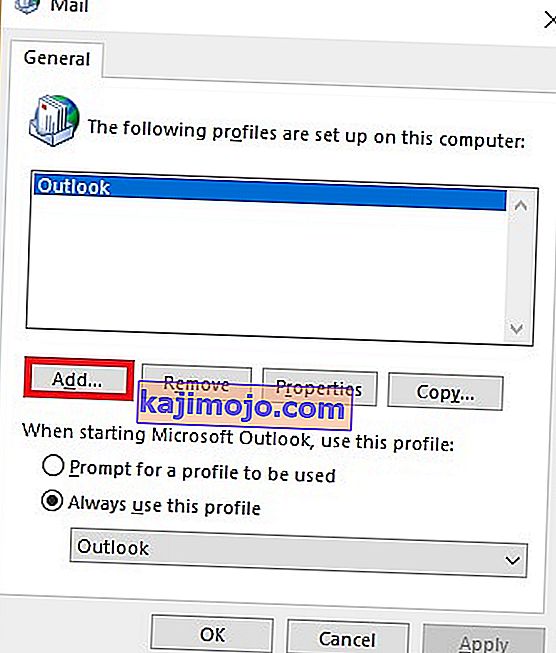
Note: Do not delete the original profile, because we don’t know if this will end up fixing the issue.
- Go through the steps of configuring your email account with Outlook. Make sure to use the same email that you have on the already created profile.
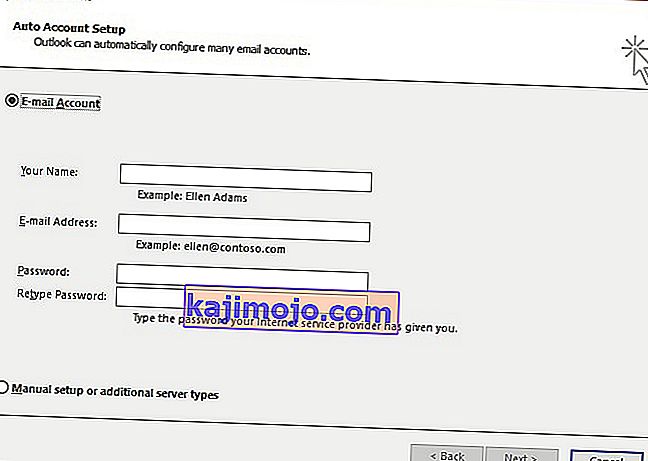
- Now return to the Mail window and make sure the profile you’ve just created is being used by default. Hit Apply to confirm your selection.
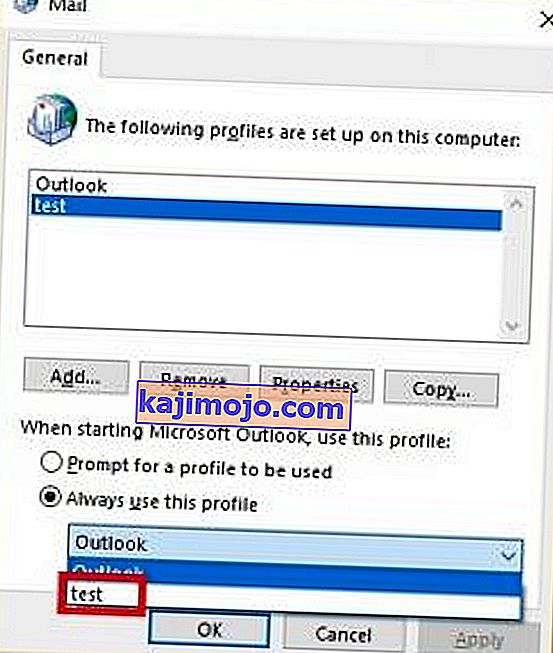
- Start Outlook again and see if it manages to start in normal mode after the profile reset.
Method 6: Checking the PST folder for corruption (All Outlook versions)
Another common cause for Outlook starting in Safe Mode is the Personal Folders File (PST). In the event that it becomes very large, or some files inside are corrupted, it might prevent the program from starting in normal mode. Luckily, you can easily check for corruption by using a Microsoft Repair tool called Scanpst.exe. Here’s what you need to do:
- Close Outlook completely and navigate to C:\ Program Files or C:\ Program Files (x86), depending on which version of Outlook you use.
- Use the search box in the top-right corner to search for SCANPST.exe.
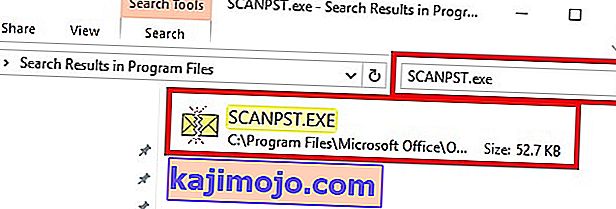 Note: If you don’t manage to find the SCANPST executable via the search bar, you need to navigate to the exact location. Here’s a list of the exact locations based on various Outlook versions:
Note: If you don’t manage to find the SCANPST executable via the search bar, you need to navigate to the exact location. Here’s a list of the exact locations based on various Outlook versions:2016: C:\Program Files (x86)\Microsoft Office\root\Office16 2013: C:\Program Files (x86)\Microsoft Office\Office15 2010: C:\Program Files (x86)\Microsoft Office\Office14 2007: C:\Program Files (x86)\Microsoft Office\Office12
- Open SCANPST.exe and set the path of the PST file you want to scan by using the Browse button. By default, the PST files are stored in Documents\Outlook Files. When you are ready, hit Start to begin the scan.
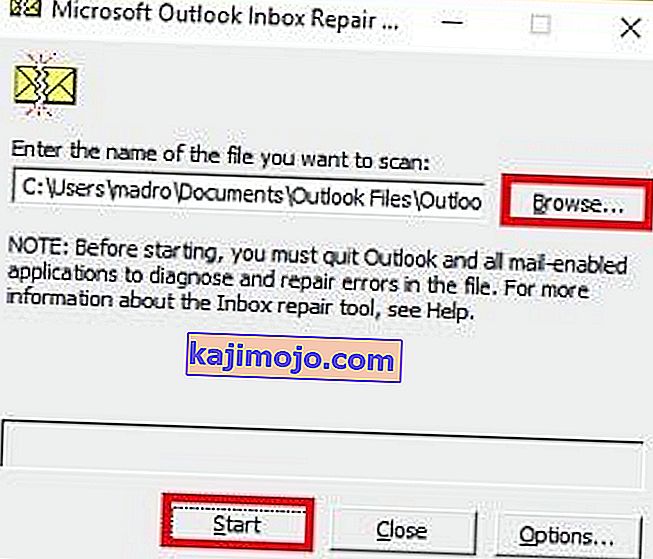
- If the scan uncovers errors or inconsistencies, click on the Repair button to fix them.
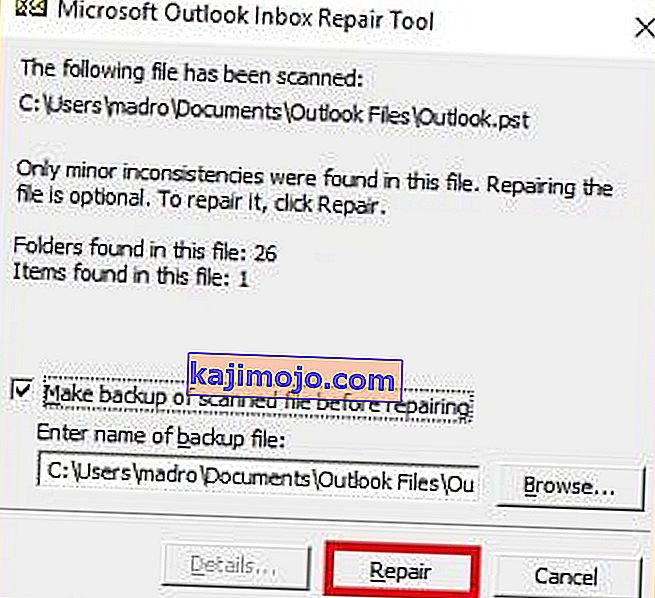
- Once the repair is done, restart Outlook with the profile that you’ve just repaired of errors and see if it starts in normal mode.
Method 7: Running the /resetnavpane command (All Outlook versions)
The navigation pane is that left portion of Outlook where you can oversee your folder list and access various icons to move between calendar, people, tasks, and mails. Sometimes, it can become glitched and prevent Outlook from starting in normal mode. Luckily, there is a command that removes any customizations to the navigation pane and gets rid of any glitch. Even better, this is done outside Outlook with ease. Here’s how:
- Close Outlook completely.
- Go to Start and access the Run application.
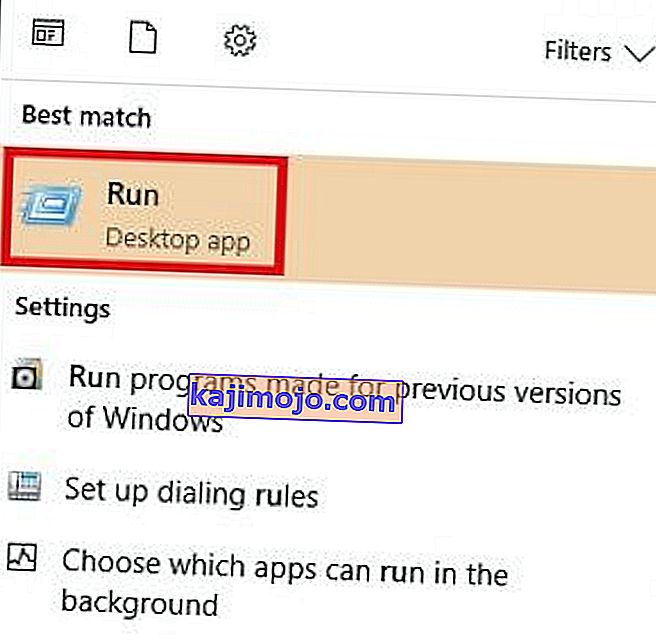
- Now, type Outlook.exe /resetnavpaneand hit OK.
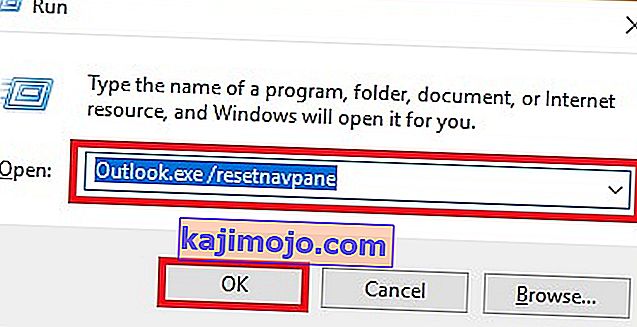 Note: Keep in mind that any customization to the navigation pane will be lost after you click on OK.
Note: Keep in mind that any customization to the navigation pane will be lost after you click on OK. - Shortly after, Outlook should automatically open in normal mode.
Method 8: Disabling compatibility mode
A lot of users have reported that they managed to start Outlook in normal mode after finding out it was running in compatibility mode. Compatibility mode is designed to help a program run as if it was running on an older operating system. As it turns out, turning off compatibility mode might just fix your Outlook Safe Mode problem. Here’s how:
- Close Outlook and navigate to the Outlook.exe on your computer. The exact path of it will differ, depending on your Outlook version. Here’s a list of the exact paths depending on your Outlook version:
2016 - C:\Program Files (x86)\Microsoft Office\root\Office16 2013 - C:\Program Files (x86)\Microsoft Office\Office 15 2010 - C:\Program Files (x86)\Microsoft Office\Office 14 2007: C:\Program Files (x86)\Microsoft Office\Office12

- Right-click on Outlook.exe and click on Properties.
- Now click on the Compatibility tab and make sure the box directly under Compatibility Mode is unchecked. Hit Apply to confirm your selection.
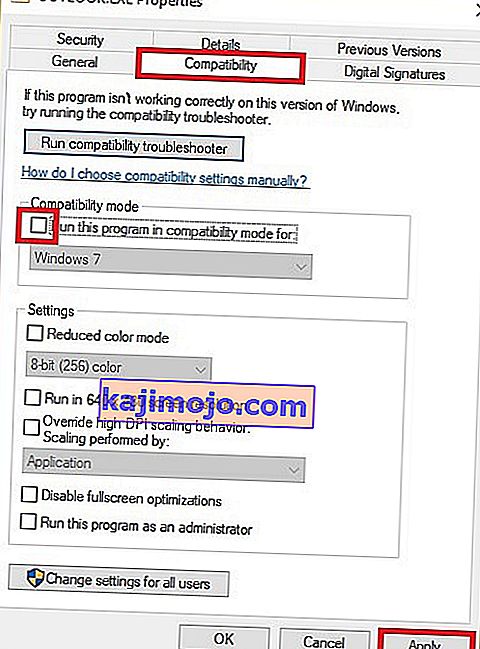
- Finally, open Outlook from the same Outlook executable and see if it manages to start in normal mode.
Method 9: Disabling hardware acceleration (All Outlook versions)
As it turns out, Outlook tries to use hardware acceleration whenever it can to make things as seamless as possible. If you’re Outlook forces itself into Safe Mode, it could very well be an issue with hardware acceleration. We can check to see if that’s the case by making some minor tweaks inside regedit. Here’s how:
- Go to Start and open the Run application.
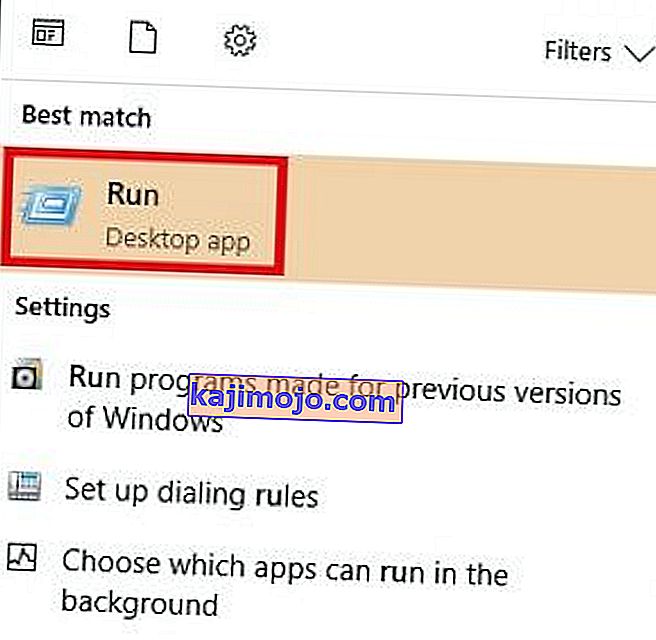
- Search for regedit and click OK to open the Registry Editor.

- Navigate your way to the following location
HKEY_CURRENT_USER\ Software\ Microsoft\ Office.
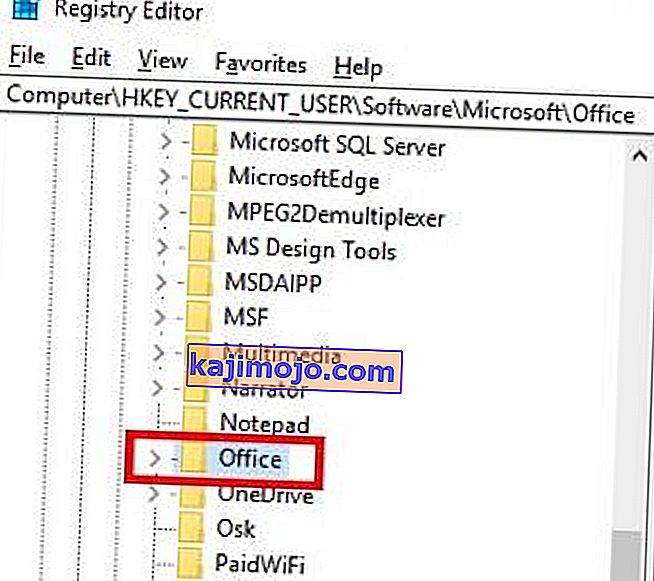
- Now, depending on which Outlook version you have, you might encounter different folders. You should either see a folder named 14.0, 16.0 or 8.0. Either way, click on the folder and double-click on the Common folder.
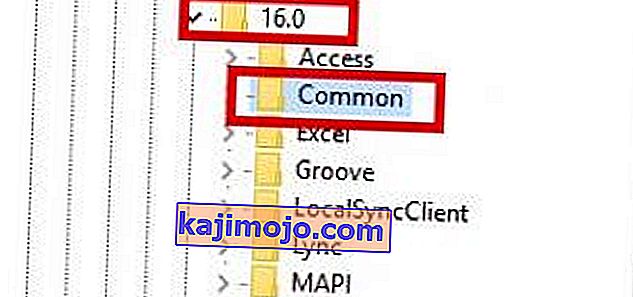
- Right-click anywhere in the Common folder, select New and click on Key and name it Graphics.
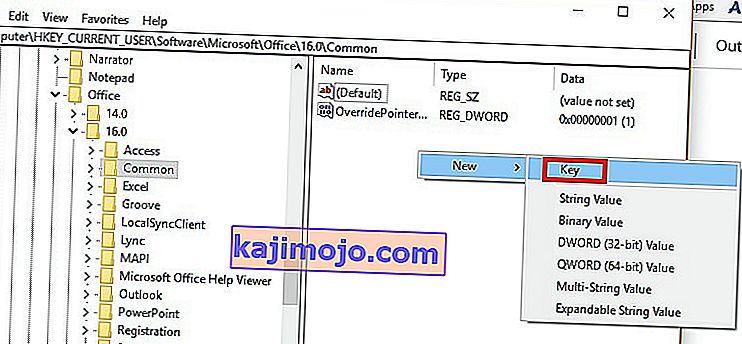
- Select the newly created Graphics folder and right-click on the right panel. From there, create a New Dword (32-bit) Value and name it DisableHardwareAcceleration.
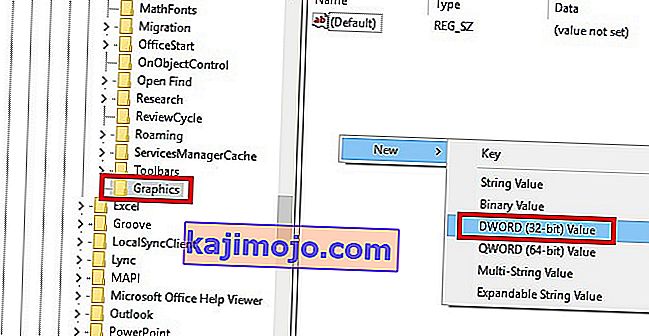
- Now double-click on DisableHardwareAcceleration and set the Value Data to 1 and hit Ok.
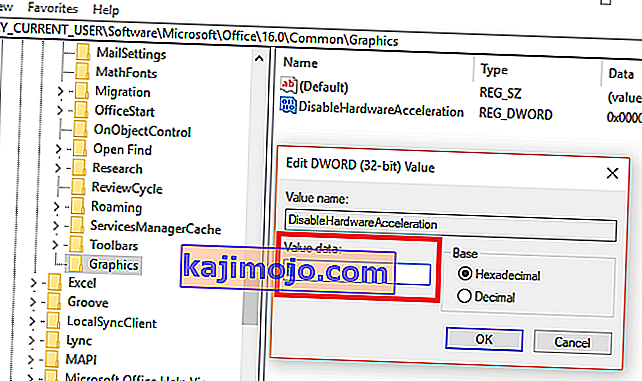
- Close regedit and open Outlook again to see if it starts in normal mode.
Method 10: Resetting the Safe Mode Registry Key (Outlook 2010)
If you have unsuccessfully followed all the methods above, there’s one more thing you can try. A final solution would be to try and prevent Safe Mode from kicking in by tweaking the registry key. But keep in mind that after you’ll follow the steps below, you won’t be able to use Safe mode in the future. At least not until you remove the key that we will create. Here’s what you need to do:
- Go to Start and open the Run application.

- Search for regedit and click OK.

- Navigate your way through HKEY_CURRENT_USER\ Software\ Microsoft\ Office.

- Now, depending on which Outlook version you have, you might encounter different folders. You should either see a folder named 14.0, 16.0 or 8.0. Either way, click on the folder navigate further to Outlook \ Security.
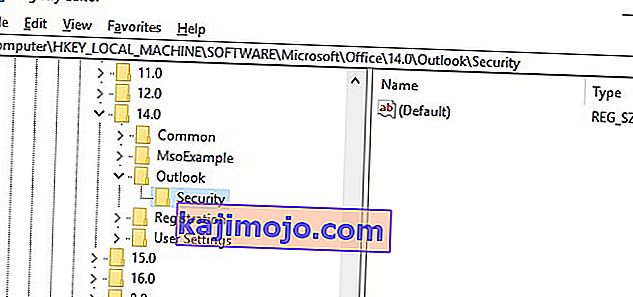 Note: If the Security folder is missing, Right-click > New > Key and type Security.
Note: If the Security folder is missing, Right-click > New > Key and type Security. - Right-click on the Security key and choose New > then DWORD (32-bit) Value.
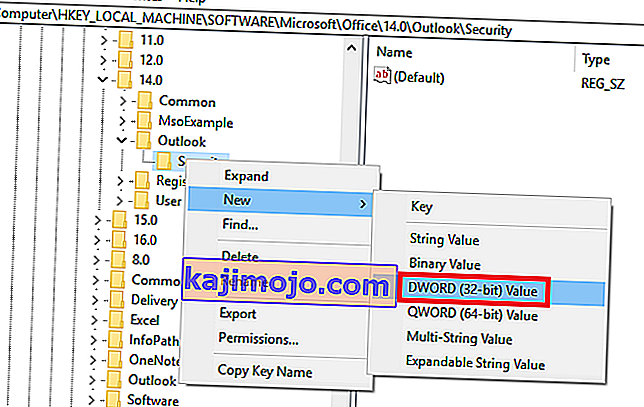
- Name it DisableSafeMode and press Enter to confirm.
- Right-click on DisableSafeMode and click on Modify.
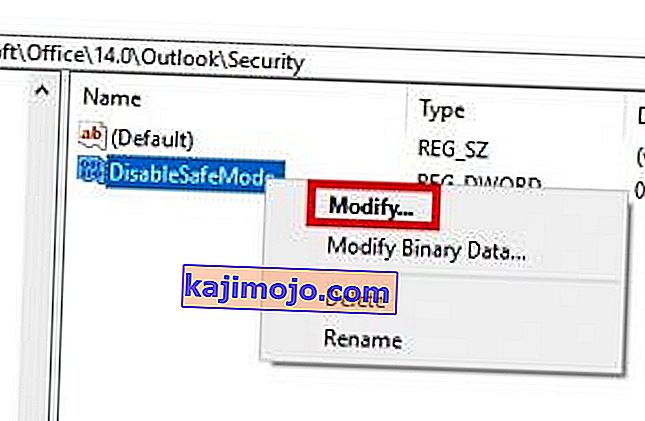
- Introduceți valoarea 1 în caseta Valoare date și faceți clic pe OK .

- Părăsiți Registry Editor și reporniți computerul.
- Deschideți Outlook și vedeți dacă pornește în modul normal.






 Notă: nu apăsați încă Eliminare . Mai întâi trebuie să confirmăm că acestea cauzează problema.
Notă: nu apăsați încă Eliminare . Mai întâi trebuie să confirmăm că acestea cauzează problema.




 Notă: Asigurați-vă că Outlook nefuncțional care a fost deschis anterior în modul sigur este închis deoarece rulăm acum una dintre copiile salvate în versiunile anterioare. Faceți același lucru pentru toate versiunile enumerate acolo. Deschide / Închide până când o vezi pe cea care se deschide fără Mod sigur. Dacă funcționează, păstrați fereastra deschisă.
Notă: Asigurați-vă că Outlook nefuncțional care a fost deschis anterior în modul sigur este închis deoarece rulăm acum una dintre copiile salvate în versiunile anterioare. Faceți același lucru pentru toate versiunile enumerate acolo. Deschide / Închide până când o vezi pe cea care se deschide fără Mod sigur. Dacă funcționează, păstrați fereastra deschisă.












 Note: If you don’t manage to find the SCANPST executable via the search bar, you need to navigate to the exact location. Here’s a list of the exact locations based on various Outlook versions:
Note: If you don’t manage to find the SCANPST executable via the search bar, you need to navigate to the exact location. Here’s a list of the exact locations based on various Outlook versions:


 Note: Keep in mind that any customization to the navigation pane will be lost after you click on OK.
Note: Keep in mind that any customization to the navigation pane will be lost after you click on OK.








 Note: If the Security folder is missing, Right-click > New > Key and type Security.
Note: If the Security folder is missing, Right-click > New > Key and type Security.

